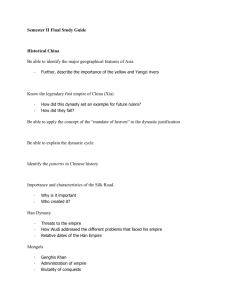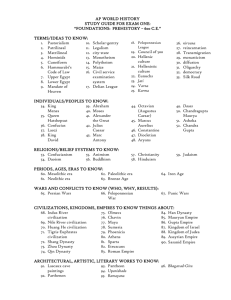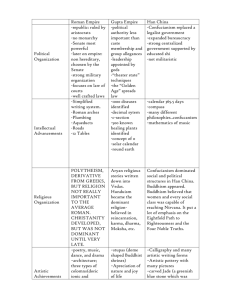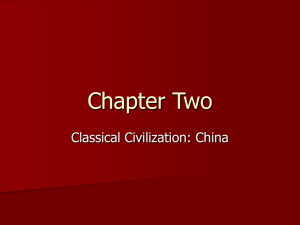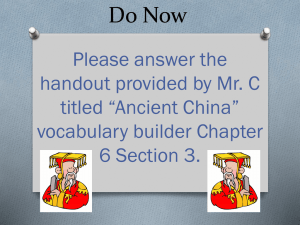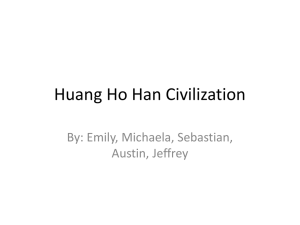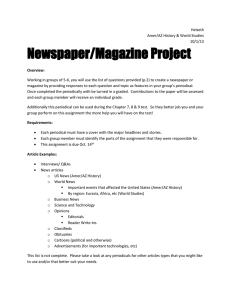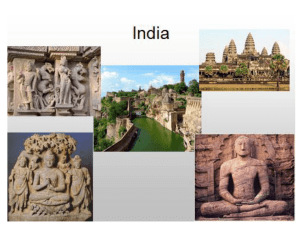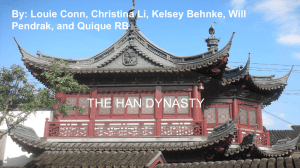Social and Gender Structure of Classical
advertisement
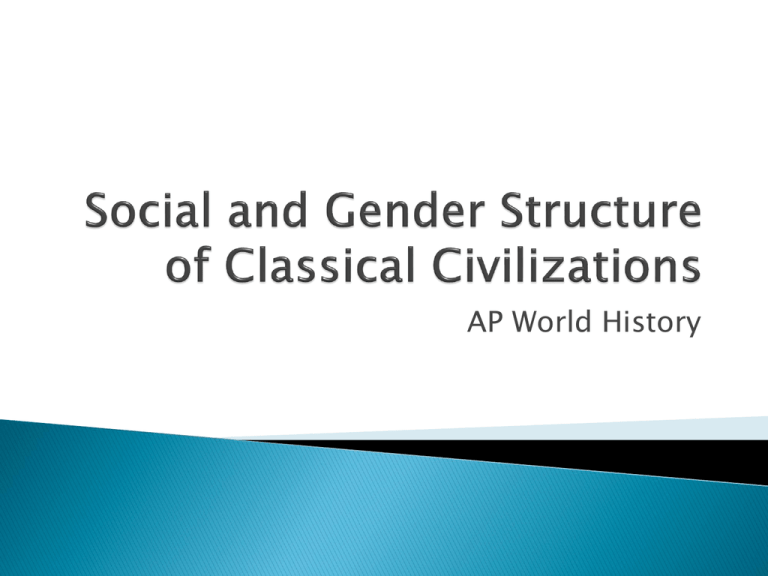
AP World History The Mediterranean- The Greeks emerged as the first classical civilization of the Mediterranean area, followed by the Romans. The Indian subcontinent-Two empires rose on the Indian subcontinent: Mauryan Empire and the Gupta Empire East Asia-China emerged from the Warring States period that followed the Zhou dynasty to form the Qin dynasty, followed by the much longer lasting Han dynasty. Greece and Greek Colonies, c. 431 B.C.E. Stearns et al. World Civilization, The Global Experience, 5th edition India in the Age of Harappa and the Early Aryan Migrations India at the Time of Ashoka The Gupta Empire Stearns et al. World Civilization, The Global Experience, 5th edition China from the Later Zhou to the Han Era Stearns et al. World Civilization, The Global Experience, 5th edition The most important social distinction in most city-states was between: ◦ Citizen ◦ Non-citizen All Spartan citizens were theoretically equal in status. Distinctions among citizens were based on athletic prowess and military talent. ◦ Spartan educational system prepared boys to be soldiers around the age of seven. Spartans maintained the system of equality based on military values even after they became an aristocracy. In Athens they developed a clear urban-based aristocracy. Class Distinctions ◦ Aristocrats-lived in the city, worked in government (political rights) ◦ Farmers-lived outside urban area (political rights) ◦ Commoners-lived in the city but were not aristocrats (political rights) ◦ Slaves-30 percent of the population (no political rights) The distinctions between commoners and aristocrats led to discontent and, in response, reforms were enacted that gave commoners more rights, including membership in the town council. Democracy spread to all free male citizens but it deepened a division between free men and slaves. Women were free and equal with men Women were encouraged to be physically fit as the men, especially so they could have strong and healthy babies. Wives did not live with husbands. In many ways women ran Sparta because men were constantly off fighting. SPARTA Gender inequality was much more clearly defined. Respectable Athenian women were confined to the home and only ventured outside under the guardianship of slaves and servants. One or two rooms of a home were served for women’s use, always away from the street. Rural women had more freedom because of their many chores. Women had no political rights, could not own property but they were allowed citizenship; in order to pass it on to their children. ATHENS Rome was a republican form of government but not a democracy. The most important ruling body was a Senate composed of patricians(elite) and plebeians(commoners). ◦ Patricians controlled the majority of all political decisions. The political structure of Rome was constantly changing due to discontent of the franchised and disenfranchised. Reforms were ushered in through Pax Romana. The basic unit of Roman society was a multigenerational family with domestic slaves. The oldest living male, the “paterfamilias”, had complete authority over his family, and he was tied to other family heads through patron-client relationships. ◦ Patrons were men of wealth who clients turned to for protection Generally upper class women were treated like children under the strict scrutiny of men of their family During a woman’s life cycle: ◦ 1st-her father was her supervisor ◦ 2nd-her husband became her supervisor ◦ 3rd-her son became her supervisor Many women had more economic freedom and were able to handle family business and the financial affairs of wealthy estates. Before the fall of Mohenjo-Daro and Harappa in the Indus valley, the Aryans had migrated into the Indian sub-continent from their home north of the Black Sea. At first, they probably had a fairly simply society consisting of herders and farmers led by warrior chiefs and priests. As they settled, however, their social complexity grew, especially as they interacted with the native Dravidians. The term caste- a social class of hereditary and usually unchangeable status. ◦ First used in India during the 16 century by the Portuguese. The Aryans used the term varna (color) to refer to their social classes. Four major Indian varnas: ◦ Brahmins-the highest social classes were the priests and scholars; represented intellect and knowledge ◦ Kshatriya-Warriors and government officials ◦ Vaishya-Land owners, merchants, and artisans ◦ Shudra-Represented by common peasants and laborers During the classical era the caste system became much more complex, with each caste further subdivided into jati, or birth groups, each with its own occupation, duties, and rituals. Each jati had little contact with they other. Women had little to no rights and were expected to be subservient. China was recovering from the Warring States period at the end of the Zhou dynasty. ◦ Warring states period was a time of political turmoil, with regional warlords constantly challenging the authority of the Zhou. Three influential belief systems affected this period and the Qin and Han dynasties: ◦ Legalism ◦ Daoism ◦ Confucianism Han China had an urban empire that ruled a rural and peasant population. The emperor lived in the forbidden city ◦ Only his family, servants and closest advisors were allowed in the city. ◦ Administrative buildings and houses of aristocrats and the scholar-gentry surrounded the forbidden city. Despite the importance of trade to the empire’s prosperity, merchants did not have a high social status. The highest regard was for the shi, or the scholar bureaucrats, sometimes called the mandarins. Confucian teachings became essential for promotion in the Han government. An examination system was set up to identify the best candidates for the bureaucracy. Theoretically, any Chinese man could take the exam but only the sons of the wealthy had the leisure to study for them. The importance of social class was reinforced by the fact that many government positions were still hereditary, and automatically passed on from father to son. Three main social classes characterized Han China: ◦ The Scholar-Gentry: This class was linked to the Shi, and eventually superseded it. Their status was based on their control of large amounts of land and bureaucratic positions in government. ◦ Ordinary, but free, citizens: The common people included a broad range, with the majority being peasants. Most peasants had a decent plot of land and lived well. All peasants were required to work a designated number of days each year on public works, and they also could be forced to join the army. ◦ The Underclass: This category included many different groups including non-Han Chinese on the fringes of the empire. They could be described as bandits, beggars, and vagabonds. China was a patriarchy, Families were run by the older men, and male children were favored over their sisters. Marriages were arranged according to family ties Women of upper class families were often educated in writing, arts, and music. Women at all social levels remained subordinate to men. Political positions were reserved for men, and only boys could sit for the examinations. Women from peasant families played traditional roles as cooks, houses cleaners, and support for men in the fields.

